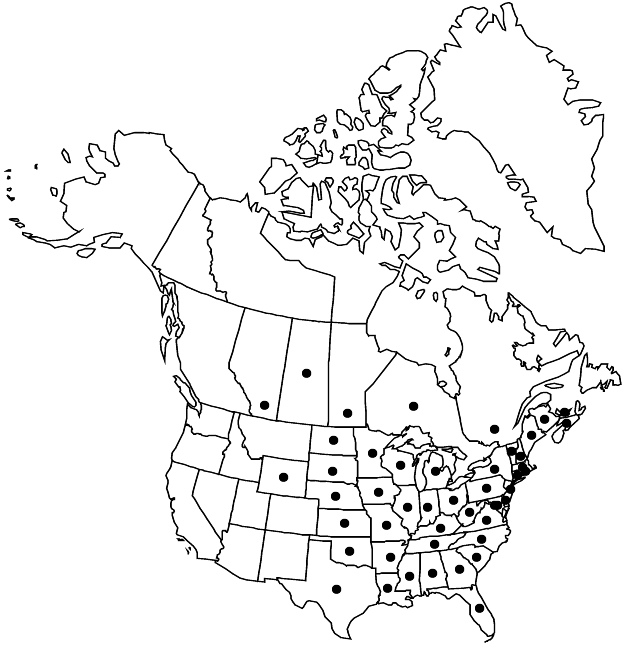Fallopia scandens
Folia Geobot. Phytotax. 6: 176. 1971.
Herbs, perennial or annual, not rhizomatous, 1–5 m. Stems scandent or sprawling, freely branched, herbaceous, glabrous or papillose to scabrid, not glaucous. Leaves: ocrea usually deciduous, tan or brown, cylindric to funnelform, 1–6 mm, margins oblique, face not fringed with reflexed hairs and slender bristles at base, otherwise glabrous or scabrid; petiole 0.5–10 cm, glabrous or scabrid in lines; blade cordate, truncate-deltate, or hastate, 2–14 × 2–7 cm, base cordate, margins wavy, scabrid, apex acuminate, abaxially and adaxially faces glabrous or papillose to scabrid, not glaucous, the abaxial rarely minutely dotted. Inflorescences axillary, erect or spreading, racemelike, 1–28 cm, axes scabrid; peduncle 0.1–7 cm or absent, scabrid. Pedicels ascending or spreading to reflexed, articulated distally, 4–8 mm, glabrous. Flowers bisexual, 3–6 per ocreate fascicle; perianth accrescent in fruit, green to white or pinkish, 3.8–8 mm including stipelike base, glabrous; tepals elliptic to obovate, apex obtuse to acute, outer 3 winged; stamens 8; filaments flattened proximally, pubescent proximally; styles connate; stigmas capitate. Achenes included, dark-brown to black, 2–6 × 1.4–3.5 mm, shiny, smooth; fruiting perianth glabrous, wings undulate or crinkled, rarely flat, (0.7–) 1.5–2.1 mm wide, decurrent on stipelike base nearly to articulation, margins wavy-crenate to incised or lacerate, rarely entire. 2n = 20.
Phenology: Flowering Aug–Nov.
Habitat: Low habitats
Elevation: 0-1800 m
Distribution

Alta., Man., N.B., N.S., Ont., P.E.I., Que., Sask., Ala., Ark., Conn., Del., D.C., Fla., Ga., Ill., Ind., Iowa, Kans., Ky., La., Maine, Md., Mass., Mich., Minn., Miss., Mo., Nebr., N.H., N.J., N.Y., N.C., N.Dak., Ohio, Okla., Pa., R.I., S.C., S.Dak., Tenn., Tex., Vt., Va., W.Va., Wis., Wyo.
Discussion
Fallopia scandens has a complex nomenclatural history, which in North America usually involves three taxonomic elements: F. scandens and F. cristata, both native in North America, and F. dumetorum, which is native in Europe. Achene and perianth characters have been used to distinguish these elements, but variable and intergrading morphologies have caused taxonomists to combine them variously. Morphometric (S. T. Kim et al. 2000) and flavonoid (M. H. Kim et al. 2000) studies suggest that F. scandens and F. dumetorum are distinct species. Where F. scandens is absent, European specimens of F. dumetorum are distinctive. This distinction is far less clear in North America, where both species occur. Experience suggests that many North American herbarium specimens attributed to F. dumetorum are misidentified.
Fallopia cristata has been distinguished from F. scandens and F. dumetorum by its smaller fruiting perianths (5–7[–9] mm) bearing narrower (1.2–1.7 mm wide), undulate-crenate or lacerate wings, and smaller achenes (2.1–2.7 mm). Extreme forms are easily identified; some specimens grade gradually into F. scandens, making recognition of F. cristata of questionable utility. S. T. Kim et al. (2000) used morphometric studies as a basis for recommending that F. cristata is best treated as a variety of F. scandens.
Selected References
None.
Lower Taxa
"/2" is not declared as a valid unit of measurement for this property.